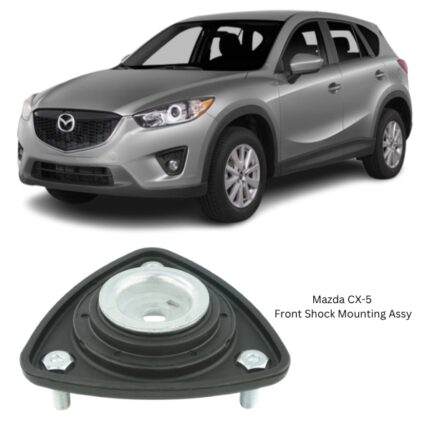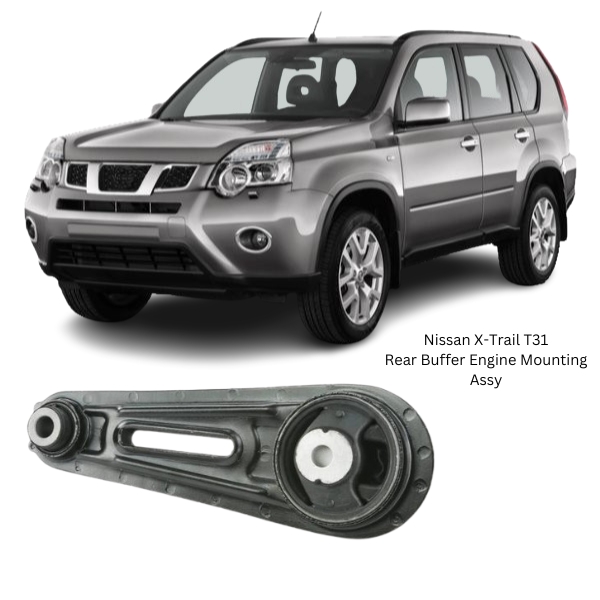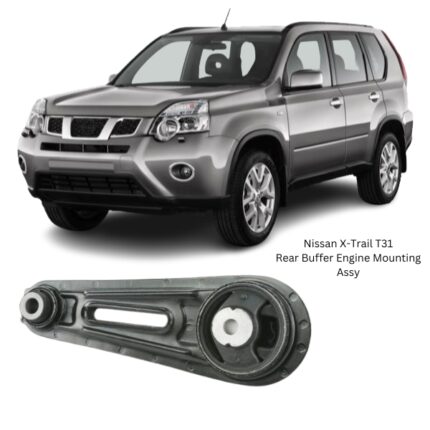Get Nissan X-Trail T31 Rear Buffer Engine Mounting Assy 11360-JD00A in Kenya
The Rear Buffer Engine Mounting Assembly, also known as the rear engine mount or rear torque mount, is a critical component in a vehicle’s engine mounting system. Designed to support the rear end of the engine or transmission assembly, this part plays a central role in absorbing engine vibrations, limiting drivetrain movement, and ensuring smooth operation during acceleration, deceleration, and gear shifting.
The performance of an engine and the comfort of the driving experience are closely tied to the quality and condition of the engine mounts. The rear buffer mount, in particular, is essential for minimizing torque-induced movements, protecting surrounding components, and maintaining drivetrain alignment.
Purpose and Function
The engine of a vehicle generates substantial torque and movement when it runs. Without mounts to manage these forces, the engine would shift excessively inside the engine bay, causing damage to connected components such as the exhaust, hoses, and electrical wiring.
The Rear Buffer Engine Mounting Assy is strategically located at the rear of the engine or transmission housing to provide damping and anchoring support. Its functions include:
-
Limiting Engine Rocking: During rapid acceleration or deceleration, the engine attempts to twist or “rock” due to torque reaction. The rear mount resists this movement and holds the engine in place.
-
Absorbing Vibrations and Shocks: The mount is constructed with rubber or polyurethane buffers to absorb engine-generated vibrations, improving comfort and reducing noise inside the cabin.
-
Maintaining Alignment: It helps keep the engine and transmission properly aligned with the drivetrain, promoting optimal performance and reducing wear.
-
Protecting Components: By reducing movement, the mount prevents undue stress on hoses, wiring, exhaust pipes, and driveline parts.
In essence, the rear engine buffer mount contributes significantly to NVH (Noise, Vibration, Harshness) reduction and vehicle drivability.
Design and Construction
The Rear Buffer Engine Mounting Assembly is engineered for durability, flexibility, and strength. It must withstand constant exposure to high engine temperatures, torque forces, and road shocks.
Key Components
-
Metal Bracket or Housing:
-
Typically made from forged steel or cast aluminum.
-
Designed to bolt onto the engine or transmission on one side and the chassis subframe or crossmember on the other.
-
Precision machined to provide an exact fit and secure mounting.
-
-
Rubber or Polyurethane Insert (Buffer):
-
Molded rubber is most common for standard mounts; high-performance versions may use polyurethane.
-
Acts as a cushion between metal parts, absorbing vibrations and minor shocks.
-
Engineered with voids, channels, or reinforcements to balance flexibility and strength.
-
-
Mounting Bushings and Studs:
-
Bushings isolate the mount from vibration transfer to the body.
-
Threaded studs or bolts secure the assembly in place.
-
-
Reinforced Center Sleeve (if applicable):
-
In some designs, a center metal sleeve passes through the rubber insert to provide a robust channel for bolts and prevent deformation.
-
Material Selection
Material quality is crucial for mount performance and longevity.
-
Rubber Compounds: Offer excellent damping capabilities. These are formulated to withstand oil, fuel, and high heat. Over time, however, rubber can harden or crack.
-
Polyurethane: Used in performance applications where greater stiffness is needed. Provides more precise control over engine movement but may transmit more vibration to the cabin.
-
Steel or Aluminum Brackets: Provide structural integrity and corrosion resistance, ensuring the mount holds up under various driving conditions.
Installation and Fitment
The rear buffer engine mount is designed for exact fitment to specific engine and chassis combinations. During installation or replacement, precise alignment and torque specifications must be followed to prevent strain or misalignment.
Installation Considerations:
-
Vehicle Support: The engine or transmission should be safely supported before removing the old mount.
-
Mount Alignment: The new mount must line up perfectly with existing bracket holes and bolt points.
-
Torque Specs: Bolts should be torqued to the manufacturer’s specifications to prevent overtightening or loosening.
-
Inspection: Adjacent mounts and components should also be checked for wear or damage during replacement.
It is often recommended to replace the rear mount alongside other engine or transmission mounts to maintain balanced support and alignment.
Common Signs of a Faulty Rear Buffer Mount
Like all rubber-based components, engine mounts degrade over time due to heat cycling, exposure to oil, and continuous mechanical stress. Failing to address a worn or broken mount can lead to increased engine movement, reduced comfort, and even driveline damage.
Symptoms of a Failing Rear Buffer Engine Mount:
-
Excessive Engine Movement: A sagging or broken mount may allow the engine to move or tilt more than usual during throttle application.
-
Clunking or Banging Noises: When accelerating, shifting gears, or going over bumps, you may hear impact sounds caused by engine contact with the chassis or subframe.
-
Increased Vibration in the Cabin: A cracked or hardened mount can no longer dampen vibrations, leading to noticeable buzzing or humming inside the vehicle.
-
Misaligned Exhaust or Driveshaft: A loose or distorted mount can affect the alignment of attached systems.
-
Visible Cracks or Wear: Physical inspection may reveal torn rubber, separated components, or leaked mount fluid (in hydraulic versions).
Maintenance and Inspection
Although engine mounts are generally maintenance-free, regular visual inspections during service intervals are important, especially in older or high-mileage vehicles. Things to look for include:
-
Rubber degradation (cracking, tearing, or hardening).
-
Metal corrosion or signs of rust on the mount body or bolts.
-
Mount movement when prying the engine slightly.
-
Contact wear on nearby components due to excessive engine shifting.
A faulty rear engine mount should be replaced promptly to avoid damage to the transmission mount, exhaust system, and CV joints.
Advantages of a Quality Rear Engine Mount
Choosing a well-designed and durable rear buffer engine mount provides several benefits:
-
Reduced Vibration and Noise: Enhances driver and passenger comfort by isolating engine tremors.
-
Stable Engine Positioning: Maintains the proper alignment of the engine and transmission for smooth power delivery.
-
Extended Component Lifespan: Protects other systems connected to the engine from excessive movement and wear.
-
Improved Driving Feel: Reduces harshness when shifting gears or accelerating, especially in front-wheel drive and transverse engine vehicles.
-
Enhanced Safety: Prevents engine displacement during emergency maneuvers or collisions.
Premium mounts may incorporate advanced materials and features like hydraulic damping chambers or dual-compound rubber inserts for optimal performance.
Follow us on Facebook for more parts.





Reviews
Clear filtersThere are no reviews yet.